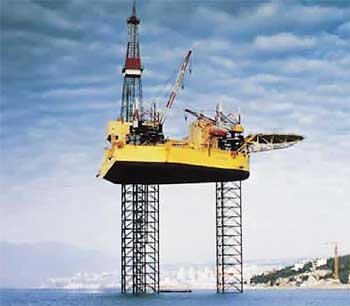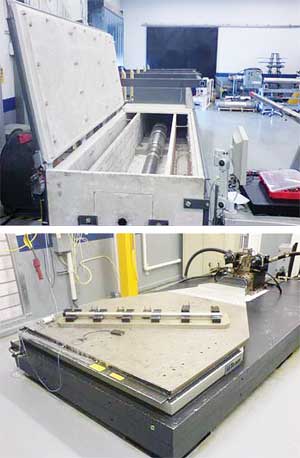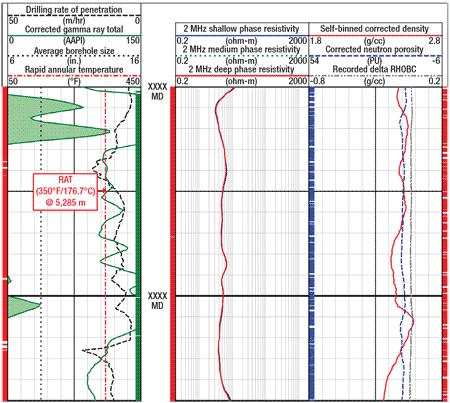Drilling with HPHT tolerant tools helps prove a multi-Tcf gas field.
Zuber A. Khan and M. Y. Farooqui, Gujarat State Petroleum Co. Ltd.; Dean Sullivan and Paul Radzinski, Weatherford International Ltd.
The use of Measurement-While-Drilling (MWD) and Logging-While-Drilling (LWD) technology has become well accepted. Until recently, temperature limitations have precluded its use in deeper HPHT environments when temperatures exceed 150°C (302°F).
While drilling a prospect in the Krishna Godavari (KG) Basin, off the east coast of India, Gujarat State Petroleum Co. Ltd. (GSPC) drilled two very challenging, but unsuccessful, exploratory wells. In these wells, the operator encountered abnormally high temperatures that approximated the capabilities of the standard MWD/LWD equipment. However, GSPC was sufficiently encouraged to fund a third well, which would be drilled deeper, pushing the temperature envelope even further.
The use of LWD techniques was of paramount importance, so plans were made and reviewed to use a drilling-fluid cooling system that would provide a bottomhole working environment within the range of standard LWD equipment. When it became apparent that this would be insufficient, GSPC sourced a hostile-environment MWD/LWD system with operating capabilities to 180°C (356°F) and a survival capacity of 200°C (392°F). This article discusses the prospect’s challenging environment, the drilling process and the MWD/LWD system that helped make it possible.
WELL KG-08
LWD systems have been developed and proven during the past 20 years and have become a standard tool for drilling both exploratory and development wells. In high-angle development wells, and especially in horizontal sections, LWD is often the only way to acquire formation data.
In June 2004, GSPC embarked on a four-well exploratory drilling program in the KG Basin, offshore Kakinada. The initial two wells, KG-01 and KG-11, were drilled using conventional LWD equipment. Although no discovery was made, a wealth of information was gathered.
Temperature in this area was much higher than anticipated. However, after drilling these two very challenging wells, GPSC decided to push the envelope even further by drilling its third exploratory well, KG-08, even deeper. This well would intensify the already challenging parameters, as the experience gained from the first two wells showed that they were extremely difficult to drill, log, case and test, with temperatures being the most challenging issue. As these wells were being drilled, the temperature rose constantly, and after each drilling phase was completed, the temperature continued to rise in the absence of circulation.
The small jackup rig that had been sourced for this project exceeded its scope on the two initial wells; the fact that they were drilled successfully was a tribute to the rig crew. These previous wells were drilled to depths of 2,620 m and 2,657 m of TVD and reached BottomHole Temperatures (BHT) of 110°C (230°F) and 115°C (239°F), respectively.
However, reaching the planned TD of about 5,000 m in the third well demanded more: higher power output, higher torque, higher flowrates, higher pressures and higher temperature capabilities for the equipment used. This last demand led to a complete reconsideration of the LWD requirements. While conventional LWD equipment could be readily used in the early drilling, the 150°C temperature capacity of standard equipment would be exceeded, and alternative approaches would have to be considered.
EQUIPMENT CHOICES
The problems associated with drilling equipment requirements were readily solved by standing down the jackup rig that had been used on the first two wells and mobilizing in its place Saipem’s Perro Negro 3, Fig. 1. This three-leg, self-elevating, cantilever jackup rig is capable of working in water depths up to 91 m and drilling to a depth of 6,100 m. The rig is equipped with a drawworks and a slush-pump system with two triplex pumps; each system is driven by two 950-hp motors, as well as a 950-hp rotary table and a 500-ton-capacity topdrive system.
 |
|
Fig. 1. Saipem’s cantilever jackup Perro Negro 3 drilled the KG-08 well. Courtesy of Saipem.
|
|
The elevated temperature problem was first addressed by considering some kind of cooling system for the drilling fluids to keep BHT below the operating maximum for standard LWD equipment. However, after evaluation, the company ascertained that it could not produce the desired conditions on a continuous basis. Though its effectiveness could not be fully quantified, a mud cooler system was used on this well, because even marginal reductions in downhole temperature could have a huge impact on the well’s success.
Since the use of LWD was considered critical to the successful drilling and completion of the lower sections of this third well, GSPC sourced the PrecisionLWD system, which had an operating envelope capable of handling the extreme conditions expected in drilling KG-08. Conventional MWD and LWD tools have been limited to 150°C (302°F); but the chosen system was rated for temperatures of 180°C (356°F) operating and 200°C (392°F) short-term survival, while being capable of handling pressures up to 30,000 psi. It also improved the precision and accuracy of MWD and LWD measurements. The system had the following components:
• The HEL MWD system, in addition to its HPHT and high-flowrate capabilities, also handles concentrations of lost-circulation material up to 80 lb/bbl. The pressure-modulated telemetry tool uses mudflow in combination with a dual-battery module to generate a positive mud pulse. It has long-duration redundant power for extended downhole operation and an environment severity measurement tool to monitor tool shock and drilling vibration.
• The high-temperature azimuthal gamma ray tool provides real-time measurement while rotating or sliding. The extreme operating requirements dictate the use of Geiger-Muller tubes. The number, size and symmetric distribution of the tubes provide statistical precision and azimuthal sensitivity.
• The Multi-Frequency Resistivity (MFR) high-temperature tool operates in all mud types, at both 2 MHz and 400 kHz, with transmitter-receiver spacings of 20, 30 and 46 in. Transmitters and receivers are fully compensated and integrated into the drill collar to increase reliability and simplify maintenance. Deeper-reading 400-kHz measurements are unaffected by eccentering and hole rugousity.
• The Bore/Annular Pressure (BAP) tool, run in conjunction with the MWD system, measures bore and annular pressure and downhole annular temperature during drilling, wiping or tripping out of the hole. The information is typically presented in equivalent circulating density to optimize hole cleaning, control surge and swab and minimize lost circulation.
All tools transmit measurements back to the MWD/LWD system to be sent uphole in real time. The parts and equipment that transmit the data between tools, such as the pipe connections, underwent the same rigorous testing to ensure reliability downhole. They were also tested using an air-hammer device to ensure the ability of the seals to resist flooding under extreme vibration, heat and pressure, Fig. 2.
 |
|
Fig. 2. Extensive temperature, pressure and vibration qualification was performed on the LWD system.
|
|
Using an Environmental Severity Measurement (ESM) board mounted on the test collar, an average shock level of 65 g and a maximum shock level of 93 g were recorded during the air-hammer test. The shock data from the air-hammer test are similar in magnitude to the most severe shock levels (80 g) seen in the field and almost twice the shock level (50 g) known to cause failures in conventional MWD and LWD tools.
DRILLING OPERATIONS
Well KG-08 was spudded on Jan. 7, 2005, in a water depth of 60 m, and the first stages were completed without incident. Thirty-inch casing was driven to a depth of 154.5 m. A 26–in. hole was then drilled vertically using 8.8–8.9-ppg, water-based drilling fluid and a conventional assembly to a depth of 501.65 m. Here 20-in., 106-lb/ft casing was cemented in place.
The 17½-in. section was then drilled vertically in two runs, using a Positive Displacement Motor (PDM) for performance drilling to a depth of 1,744 m, while gradually increasing the weight of the water-based KCl drilling fluid to 9.5 ppg. At that point 133⁄8-in., 68-lb/ft, N-80 casing was set.
The 12 1⁄4-in. section also used a PDM. From 1,738 m, an 8-in. MWD system was used, which included a gamma ray, MFR, BAP and ESM sensor package. This section was drilled to a depth of 3,617 m in three runs while drilling-fluid weights were gradually increased to 11.5 ppg.
On the third run, the BHA became packed off and stuck. Efforts were made to free the string, but after no sign of success, the operator decided to back off, set a plug and sidetrack the well, leaving the LWD string in the well. As a result, the memory could not be downloaded. However, real-time data had been acquired and recorded throughout the section, so no data were lost.
The sidetrack from vertical was difficult, since the clay-stone formation was hard and difficult to penetrate, requiring the setting of a very firm cement plug at 3,195 m, the kickoff point. The sidetrack of the 12¼-in. section was successful, reaching a maximum deviation of 19.8° and then dropping back to 7.23° at 3,825 m, the section TD. At that point, a full 95⁄8-in., 53.5-lb/ft, P-110 casing was run and cemented.
Unfortunately, the sidetrack changed the well profile to S-shaped, which added even more drilling challenges, such as torque, drag and hole-cleaning issues. LWD was not used in the sidetracked portion of the 121⁄4-in. section, since it was run in the original section.
Once the sidetrack was complete, the operator decided to use the new MWD BHA in the 8½-in. section. The objective was to hold angle without creating any unnecessary doglegs and drill to TD. TD was reached successfully at 4,728 m, with drilling-fluid weights peaking at 14.4 ppg, while acquiring as much data as possible. The MWD system was used throughout the well, from 1,738 m on Feb. 5 to the 4,728 m-TD on April 13. Fifeen separate runs were made, with data being successfully transmitted and recorded at surface throughout.
On occasion between bit runs, wireline logging tools would be run into the hole. However, this operation was not performed after every run, since the LWD provided the required information over these intervals and because the time consumed by wireline logging operations allowed the static BHT to continuously rise. Higher temperatures were being encountered after drilling because of the absence of drilling fluid to cool the hole. This situation emphasized the effectiveness of running LWD equipment at all times when the extreme temperatures were at their lowest, and the LWD data put to rest arguments as to quality, Fig. 3.
 |
|
Fig. 3. The LWD tool produced good data at extreme temperature.
|
|
In one of the most challenging drilling environments in India, formation evaluation data were already available as the drilling reached TD. The time and money saved by using an MWD/LWD system that would perform in this environment were significant. Throughout the drilling of the well, GSPC was able to make real-time decisions to correlate with the previous wells, pick core points and casing points, select sections to log with wireline, monitor hole cleaning, optimize mud weight and detect packoffs.
After drilling this well, a full suite of wireline tools were run, confirming the operator’s discovery and fully verifying the LWD data’s accuracy. The well was cased and tested. In June 2005, GSPC tested two zones in KG-08 and announced a major discovery with multi-Tcf estimated gas reserves. Not only is this India’s biggest gas discovery in the Lower Cretaceous reservoir, but it is also one of the deepest wells drilled in the KG Basin. The success of HPHT LWD tools increased GSPC’s confidence level with this technology for its upcoming KG wells.
As a result of drilling the KG-08 well, a few lessons were learned that were put to use in drilling subsequent appraisal wells. The technique of “staging” the BHA into the hole on each trip became a fundamental practice to assist the mud coolers, because the temperature would rise noticeably—as much as 30°C (86°F)—between bit runs.
In future wells, the operator plans to use the rapid annular temperature tool to accurately measure small, quick changes in temperature and the effectiveness of mud coolers. Adding stabilization modules can be advantageous when drilling through known hard and dense formations. Wireline logging will be minimized, since the quality and accuracy of the LWD logs were more than acceptable for decision making.
CONCLUSIONS
The successful drilling of well KG-08 and its eventual completion as a major discovery were a tribute to long-term planning and to the use of newly developed technology, the MWD system and LWD tools. The equipment proved itself in a subsequent directional appraisal well (KG-15), which was drilled in a “J” profile to probe the extent of the structure lying in deeper water. During the drilling process, a powerful gas kick was taken, resulting in the well being shut in without circulation for several hours, with the LWD equipment on bottom. However, when the well was brought back under control, the LWD equipment was functioning normally, despite long-term exposure to a BHT of 176°C (349°F)—thought to be an industry record at the time. 
ACKNOWLEDGMENTS
The authors thank the management of GSPC and Weatherford International Ltd. for their permission and encouragement in publishing this article. The authors also thank the field crews and operations teams of Weatherford and GSPC for their support.
|
THE AUTHORS
|
 |
Zuber A. Khan earned a BSc with honors and an MSc degree in geosciences and a PG diploma degree in hydrogeology from Aligarh Muslim University (AMU) in Aligarh, India. He started his career with Geoservices as a mud logging geologist in 1995, where he monitored and supervised more than 300 drilled wells. In 2000, he joined GSPC, where his responsibilities are focused on the KG Project, an ultra-HPHT field. Khan is Manager, Geology for Gujarat State Petroleum Co. Ltd.
|
|
| |
M. Y. Farooqui earned BSc with honors, MSc and MPhil degrees in geology from AMU. He joined GSPC in 1994 and heads a group responsible for conceptualization of exploration strategy, field development plans, annual work program and budget and also responsible for ensuring oil/gas production targets under various joint venture projects. He has published technical papers in national and international journals. Farooqui is General Manager, Planning and Development, and is a Director in several GSPC subsidiary companies.
|
|
| |
Dean Sullivan earned a BS in mechanical engineering from Memorial University of Newfoundland. He started his career as an MWD/LWD/RSS Field Engineer and worked in many countries before becoming LWD Coordinator of India, then MWD/LWD/RSS Manager of South Asia with a focus on HPHT Environments. Recently, Sullivan has become Weatherford International’s Country Business Unit Manager, Drilling Services, for Brazil.
|
|
| |
Paul Radzinski earned a BS degree in physics from North Adams State College. He has 28 years of global industry experience working in technical, business development, management and marketing positions for Schlumberger, Eastman-Christensen, Sperry-Sun and Precision Drilling in various operational, technical and management positions for wireline and LWD product lines. Radzinski is Drilling Services Marketing Manager for Weatherford International, based in Houston.
|
|
| |
|






